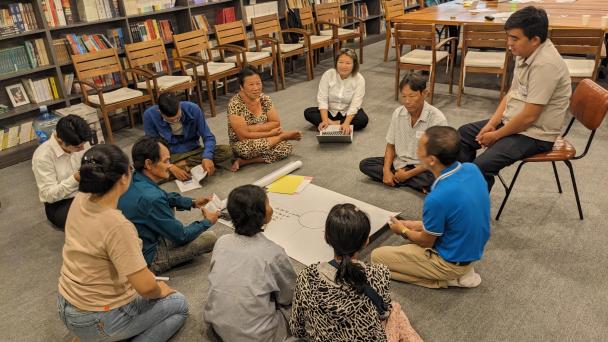A journey through time: 60 years of the National Travel Survey

The National Travel Survey (NTS) is the primary source of data to monitor personal travel trends and inform travel policies in England. Designed as a household survey, it consists of a face-to-face interview and a self-administered travel diary. This diary collects information about the travel behaviours of household members over a 7-day period. While the diary has traditionally been administered on paper, the intention is that this will transition online from 2025.
While this shift echoes broader trends in survey research, changing data collection modes can impact the quality of the data and potentially disrupt the continuity of the time series. Recognising these important implications, the Centre for Social Survey Transformation at NatCen is collaborating with the Department for Transport and the developers of the digital diary, Ghost (Digital) Limited, to better understand mode effects on the travel diary. As part of this workstream, we conducted a pilot study between November and December of 2022, with three primary goals:
In this post, we summarise key findings from the first two objectives.
For this study, ten experienced interviewers underwent a half-day training session and subsequently visited 100 pre-selected addresses. Unlike the standard NTS approach, we used a purposive sampling strategy, oversampling rural areas to assess potential connectivity challenges in less populated areas. The pilot adopted a "digital by default” approach, inviting household members to complete the diary online, with a paper option only available to those unable or unwilling to participate online. Additionally, due to constraints on the fieldwork period, some procedural changes designed to ensure representation of different days of the week and month were made in the Pilot. These changes included removing staggered interviewer start dates and variable travel weeks. In the Pilot, all interviewers had the same start date, travel weeks, and a smaller assignment size than in the standard NTS approach.
Overall, interviewers’ feedback regarding the inclusion of the digital diary into the NTS was highly favourable. They found the system easy to use (see Figure 1) and reported that respondents found it intuitive. As an interviewer noted:
“This is a great step towards being paperless. Better for the environment. It's easy to administer […] The respondents were generally accepting of the format and were not expecting a paper version. It was generally time-saving and easy to access remotely”
Supporting the interviewers’ perception that the diary was well-received in the field was the high take-up of the digital mode. Out of 79 diaries completed across 38 households, 30 households (79%) chose the digital mode. Among these, 28 households completed all diaries digitally, whereas two combined paper and digital modes (see Figure 2).
A key metric from the NTS is the average number of trips made by residents of England. The pilot, drawing from 935 trips made by 74 individuals, yielded an average of 12.6 trips. This is closely aligned with the NTS figures from November 2022 (12.9) and the 2022 weekly average (13.1) (see Figure 3 for a comparison of trip rates between the Pilot study and the mainstage NTS from January to October).
On Day 1 of the travel diary, unlike subsequent days, respondents are asked to record short walks, defined as those under a mile. As a result, the trip count on Day 1 is expected to be higher than the other days. In the Pilot, the average number of trips on Day 1 was slightly below the estimates from the November 2022 NTS (1.7 vs. 2.5) and the 2022 average (1.7 vs. 2.4).
This lower trip rate on Day 1 might suggest potential underreporting of short walks in the digital diary. However, these results should be interpreted with caution because a high proportion of diaries in the Pilot had no trips on Day 1 (41%). This proportion is higher than in the mainstage NTS (November 2022: 33%) and it is possible that procedural differences between the Pilot and the mainstage (e.g., fieldwork length, interviewer start dates) could have contributed to this discrepancy. Trips on Day 1 will be explored further in the next stage of testing, scheduled for Q1 2024.
Distance data from the 7-day diary is consistent with a potential underreporting of short trips in the Pilot. Trips under 3 miles, especially those under a mile, were reported less often: 30% in the Pilot compared to 47% in the mainstage 2022 data (see Figure 4). Similarly, distances reported at the stage level (e.g., each segment of a trip), which are typically shorter on Day 1 due to the inclusion of short walks, showed an inconsistent pattern in the Pilot (see Figure 5).
Regarding transport modes, as would be expected, cars were dominant in both the Pilot study and the mainstage NTS. Walking was the second most common mode, albeit at distance. The proportion of walking trips was slightly lower in the Pilot (12%) compared to the main NTS (15%), which might be linked to the potential underreporting of short walks. It is important to note that transport modes are recorded as open text in the paper diary, whereas in the digital version, they are presented as a pre-coded list with radio buttons. These presentation differences could influence the response process, especially during the recall stage, contributing to potential differences between the paper and the digital modes.
In both the pilot and the main NTS, the primary reasons for travel were:
Other common reasons for travelling included day trip or walks, grocery shopping, and participation in entertainment or public activities (see Figure 7).
Overall, the results of the Pilot are encouraging, indicating both high adoption rates of the new mode in the field and positive feedback from interviewers. However, these findings are based on a small, non-random sample of households, and a small group of experienced interviewers, which limits the generalisability of the results. In addition, due to sample size constraints, data from both digital (main mode) and paper diaries were pooled for analytical purposes.
To address these limitations, a large-scale quantitative study is scheduled for Q1 2024. In this upcoming study, the Centre for Social Survey Transformation and the Department for Transport will compare the digital diary with the paper diary using a split-ballot design. The findings from this experiment will provide robust evidence on mode effects and their impact on survey estimates. This information will be used to inform decisions regarding the implementation of the digital diary from 2025 onwards.




Receive a regular update, sent directly to your inbox, with a summary of our current events, research, blogs and comment.
Subscribe